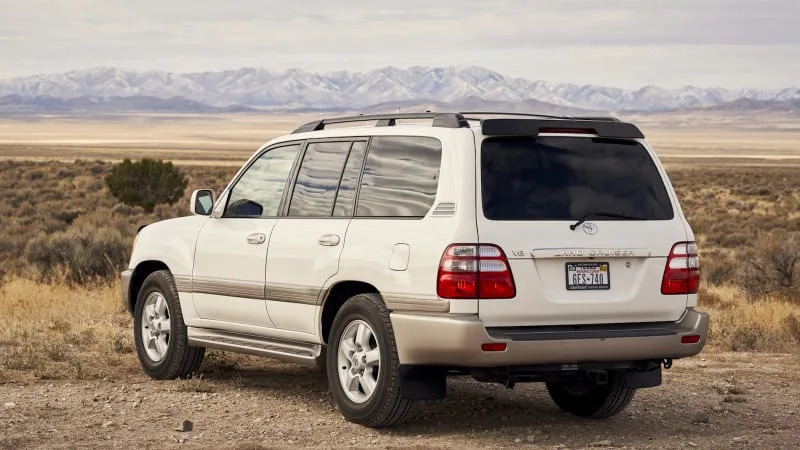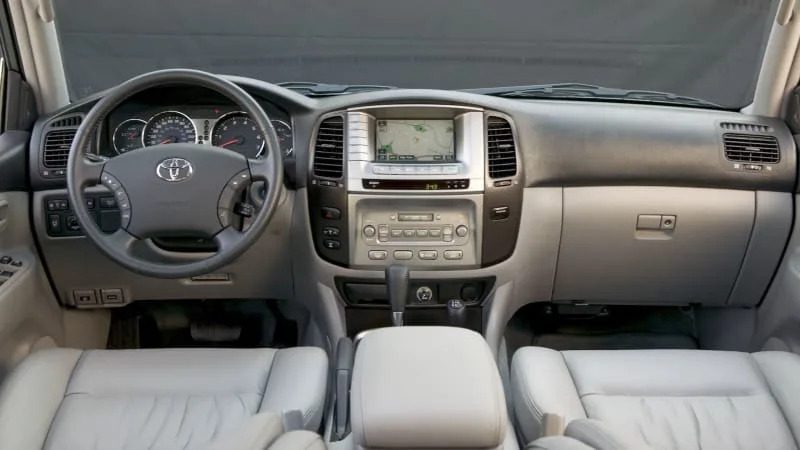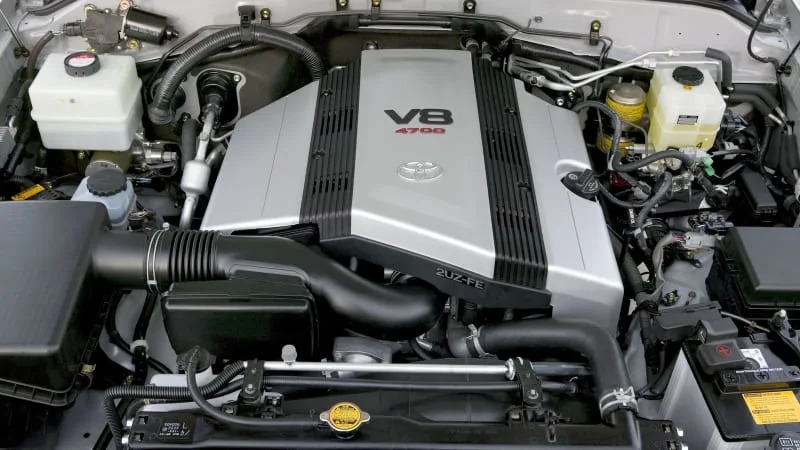Future Classic: 1998-2007 Toyota Land Cruiser (FJ100)

This might be considered the Land Cruiser responsible for Toyota pulling the historic model from the U.S. market and giving us a new, smaller, less expensive Cruiser. And that’s ironic because the fifth-generation truck known as the 100 Series, codename UZJ100, was designed to appeal to the U.S. market.
By the late 1990s, SUVs and the SUV segment were getting larger, more Americans were buying and driving SUVs every day, and more Americans were willing to pay more money for them. When Toyota decided to brand engineer a Lexus off the previous-gen 80 Series Land Cruiser (sold from 1990 to 1997), the result was the inaugural LX 450 that hit the market in 1996.
As MotorWeek said in a 1998 broadcast (it’s also embedded a little further down below), the LX 450 wasn’t quite Lexus enough. So, just as Toyota had upgraded the Camry in to make a better base for the 1997 Lexus ES 300, the 100 Series Land Cruiser stepped up to provide a better platform for what would be the Lexus LX 470. The Toyota engineer known as “Mr. Land Cruiser,” Takeo Konda, called the 1998 Land Cruiser the biggest advance in the model’s history.
The easy bit was making the 100 Series larger than the 80, more roomy, quieter, and much nicer inside, with more safety features. The controversial bit was Toyota jettisoning what Cruiser aficionados considered quintessential components of the Land Cruiser formula. Toyota replaced the 4.5-liter 1FZ-FE inline-six engine with the 4.7-liter 2UZ-FE eight-cylinder. This cast-iron-block engine with 230 horsepower and 320 pound-feet of torque was designed for truck-like durability (the 1UZ-FE and 3UZ-FE V8s in the Lexus LS used aluminum blocks). As the first V8 Toyota put in one of its SUVs, the mill debuted in the Land Cruiser and sibling Lexus LX 470, followed by the 4Runner, Sequoia, and Tundra.
But what shocked fans most was Toyota dropping the solid front axle, a feature of every Land Cruiser since the precursor Toyota Jeep BJ in 1951. (An inline six had been the sole or an optional engine since then, too). The new independent front suspension came with double wishbones and torsion bars, paired with rack-and-pinion steering. Some overseas markets got a Cruiser codenamed FJ105 that retained the inline-six and solid axle, but not North America.
Why is this Toyota Land Cruiser a future classic?
Because the 100 Series succeeded at the mission of luring North American buyers, but it did so as the LX 470. The Cruiser got left behind.
According to figures at Car Sales Base, the 100 Series Land Cruiser outsold the sibling Lexus 470 in the U.S. by about 3,000 units for the first two years of its life. Come 2000, the gap narrowed to about 800 units. From 2001, the LX 470 outsold the Land Cruiser every year but one in the U.S. right up to when Toyota retired the Cruiser here in 2021.
As the Lexus continued to get nicer and more expensive, the Land Cruiser did as well, the Cruiser’s MSRP tracking with the Cadillac Escalade. The 1998 Land Cruiser started at about $46,500, roughly $700 more than a 1999 Escalade. The 2007 Land Cruiser started at almost $57,000, about $400 below the Escalade and $900 above the just-launched Mercedes-Benz GLS 450. The quandary then was that for any shopper after a hardcore truck, there was almost no reason to spend large on a luxurious Land Cruiser.
And for the rock crawling and expedition types that had always tested and proved the Land Cruiser’s reputation, getting used to the independent front suspension would take some time. The 100 Series was still a sensational off-road rig. Twenty-five years on, though, Cruiser owners are still happy to debate whether the 100 is a better overall expedition truck than the 80. What we believe few will debate is that the spiritual overlanding heir to the 80 Series is the Toyota Tacoma pickup, not the 100 Series.

For all these reasons, the 100 Series was less loved than it could have been. The 80 Series sold 80,990 units during its eight model years on the U.S. market, the 100 Series moved 87,727 units during its ten years on the market, a lower annualized rate.
On Classic.com, which tracks up to 5 years of sales all over the Internet, the 80 Series’ stats at the time of writing — just counting the 1992 to 1997 model years with the larger 4.5-liter engine — are 280 sales totaling nearly $8 million, the average transaction price $28,420. The same stat line for the 100 Series is 202 sales over the past five years with nearly $4.5 million in transaction volume, for an average of $22,509. And both of those fall behind the certified classic 60 Series Land Cruiser and its $31,538 average transaction price over five years.
The 100 Series is the much nicer, more advanced, and (nearly?) just-as-capable bargain.
What is the ideal example of a 100 Series Land Cruiser?
There’s no year that’s a bad choice. Toyota engineered the underlying truck to be so tough that model year isn’t a big issue; the primary changes over the years were engine output going from 230 hp to 265 hp, minor mechanical upgrades most drivers wouldn’t notice, and the list of available and optional features like navigation.
Mileage isn’t a huge factor considering the engine’s Methusela-like longevity given decent care; 300,000-mile trucks are still great daily drivers. It’s service history and current condition you’ll want to note.


For overlanders, check out Cruisers after 2003 with stronger driveshafts, better cooling, and optional tow hitch. And pre-2006 models will not have the optional active height control suspension fitted to the Lexus from 1998. Land Cruiser specialists Slee Offroad has a list of model-year changes for the 100 Series and LX 470, handy for zeroing in on drivetrain desires.
Be sure to check out our used vehicle listings; they can be helpful for finding a good deal. You can narrow the options down by a radius around your ZIP code, and be sure to pay attention to the deal rating on each listing to see how a vehicle compares with others in a similar area.
Are there any good alternatives to the Land Cruiser?
If you’re looking for the mightiest bargain, the best 100 Series Land Cruiser is, again, the LX 470. Classic.com has registered 276 sales of the LX 470 in the last five years, the roughly $6.2 million combined transaction value equating to an average of $22,483.
For shoppers wanting a calm, collected daily driver, the LX 470 is the choice, since Lexus loaded it features that couldn’t be had on the Land Cruiser depending on model year. As an unabashed luxury monster with lots of tech, though, taking care of older electronics needs commitment and some money.
Related video:



